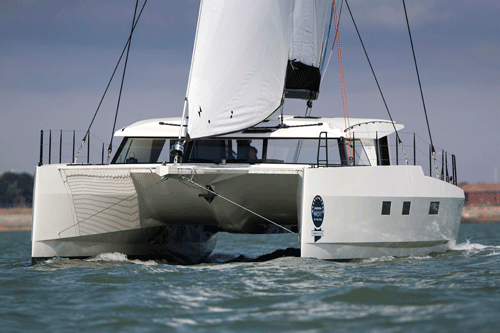“It’s sailing Jim, but not as we know it.” Yachting World's video of an intriguing and innovative new British built Rapier cat. Prepare for the unexpected.
Broadblue’s Rapier 550 is the sailing version of the USS Enterprise – a spaceship of a catamaran that will appear totally foreign to most sailors. She has no external cockpit, no aft deck and a potential average speed of 15 knots. The cockpit, winches and wheel are all inside her vast superstructure, designed to allow one person to push-button control her from within without compromising performance. But is this radical looking British boat ahead of her time?
Step aboard the Rapier 550 and your jaw will drop. This is an entirely new breed of boat, one that could potentially appeal to monohull, multihull and motor boat cruisers alike. She is designed for fast ocean cruising, and can potentially reel off 350nm days.
Nic Bailey teamed up with Darren Newton and his Multimarine yard to create this futuristic production boat for Broadblue. A clever winch station was designed around the mast compression post. All sheets and running rigging can be worked via three electric winches. Reliance has been placed on a digital switching system and these reversible winches so sheets can be trimmed or eased remotely – certainly not most people’s idea of a long-distance cruiser.

The word ‘foreign’ soon littered my notebook during our trials. To sit at the bridge feels peculiar enough, and I felt uncomfortable not being able to see the mast from the helm. But it is when you try to sail her that the Rapier seems truly alien. Indeed, the use of a car’s steering wheel and seat for helming, plus remote manoeuvring and operation, will make her more familiar to motor boaters than to sailors. It felt as though we were in a simulator, watching the Solent pass by from behind a screen and the hydraulic steering does little to help connect you to the sailing experience. Thankfully, the Rapier provides the option for tillers to be mounted directly over the stocks on each quarter to give the wind-in-the-hair experience.
The Rapier certainly offers comfort on passage. Whether on or off watch, the space and light below is astonishing, and the focus on looking forward helps connect crew to the surroundings. The point of the all-encompassing superstructure is to prevent the need to go out into an exposed cockpit and to keep the yacht light, by removing the need for an extra bimini or furniture.

Today’s cool, fast cat designs will only sail as fast as they look if weight is kept to a minimum. The hull and deck of the Broadblue weigh just three tonnes. Heated vacuum tables and epoxy tooling were used to save weight and the whole hull is vacuum-infused in epoxy in a one-piece moulding. “The glass is the decadence on the 550,” says Newton. “To go to so much effort to make the boat light, then stick 0.5 tonne of glass on it seems wrong. But she is built so light, so she can have these features.” The 9.5 tonne Rapier is still nearly one-third the weight of a Lagoon 52.
The spreader-less rig is a good example of the use of modern design to create a simplified, lightweight solution. Future Fibres’ Torbjorn Lindersen was charged with creating a strong, stiff, reliable carbon tube with the cleanest rigging possible. The innovative result is that the lowers are swept forward. Deflection is forced in permanently, so the rig should be stiffer than traditional aft-swept designs when in heavy, reefed conditions.
The Rapier is a space-age boat that has been built very well, and designers deserve credit for lateral thinking. I admit to being sceptical whether the outside-in approach would work at sea – but have to admit that with familiarisation came appreciation. The final finish needs improving, mainsail views from within are almost non-existent and I have reservations about the safety of the remotely controlled winches in the internal cockpit.
Innovation should be encouraged however and given a few improvements the Rapier will appeal to an increasing crossbred market sector.
See the full report in the November issue of Yachting World, out now.
Images and video by Paul Wyeth




